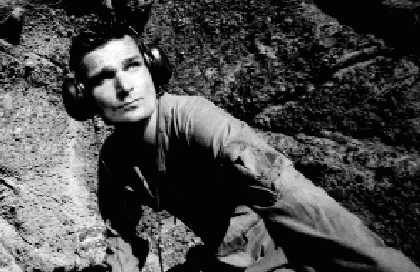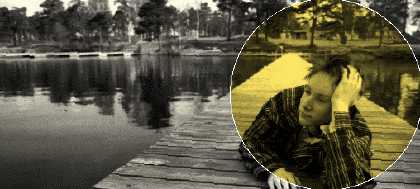Join the Dot
Hari Kunzru on the evolution of electronic music
The arrival of electronics created a series of ruptures in musical sound production. Before amplification and sound synthesis, music was always rooted in the body, in the gestures of the musician, the acoustics of a particular instrument. It was also precisely located in space and time. Musical instruments evolved according to available materials, and in order to fulfil the requirements of particular performance traditions. The sound of the clarinet is a product of the colonial trade which brought dense tropical hardwoods to Europe, woods with different acoustic qualities from the native European hardwoods that had previously been used to build wind instruments. The Senegalese kora uses a particular species of gourd to form its resonating body, its sound a direct function of the high rainfall and subtropical temperatures of West Africa.
So the twang of a steel guitar signifies the American South West, and a pan-pipe the Andes in a very direct, embodied way. Embedded in the tonalities of such traditional musical instruments are powerful accretions of significance, meanings that are transmitted to the listener without the mediation of language. No wonder music, with its suggestion of particularities of place and history, has so often been made complicit with blood-and-soil nationalism.
By contrast, a synthetic electronic tone seems to exist simply as a point in the phase space of all possible tones. It appears in the world bereft of history, its very lack of significance becoming, at least for the first generation of electronic music, its primary significance. Unmodulated tones, 'pure' sounds built from sine waves, square waves, sawtooth waves seemed, when they were first heard, to be a sort of sonic platonism, original, perfect, emptied of human meanings. Playing a national anthem on a synclavier could, in the nineteen-seventies, be a politically charged act. A huge irony, since electronics was such a total rupture with the past. In the early days of the Moog the machine was often used to remake traditional classics. "Switched-on Bach" was history dissolved into disneyfied kitsch, a toilet joke on the notion of the great European tradition, because the 'meaning' of the Moog, for the first generation of users at least, lay in its ahistoricity. Of course the best known manipulators of this new Futurism were Kraftwerk. Their synthetic sounds signified absence of emotion, of romantic sentiment, memory, of all the wave patterns of the past. They wrote hymns to home computers and pocket calculators. They threw into the gutter the romantic nationalism which had brought Germany so low during the twentieth century, while at the same time constructing an image that toyed with 1940s fashion, Fordist-Taylorist notions of mass production and repetition, all the dangerous auratic politics that still hung around electronics, with its tireless repetition, its infinite reproducibility. Where was the flesh? Absent or disciplined. We are the Robots. Work might just still make us free.
Of course the best known manipulators of this new Futurism were Kraftwerk. Their synthetic sounds signified absence of emotion, of romantic sentiment, memory, of all the wave patterns of the past. They wrote hymns to home computers and pocket calculators. They threw into the gutter the romantic nationalism which had brought Germany so low during the twentieth century, while at the same time constructing an image that toyed with 1940s fashion, Fordist-Taylorist notions of mass production and repetition, all the dangerous auratic politics that still hung around electronics, with its tireless repetition, its infinite reproducibility. Where was the flesh? Absent or disciplined. We are the Robots. Work might just still make us free.
Twenty years later, electronics now has a history. The analogue sounds of Moogs and Prophets and Oberheims don't signify pure Futurism any more. Rather, we hear in them past futures, in much the same way as we watch Metropolis or Lost In Space, experiencing defunct virtualities which now only speak about the time of their production.
More straightforwardly, other sounds are beginning to take on sentimental and emotional resonances in the same way as acoustic instruments. In fifty years' time listeners will hear the tortured acid 303 patch in the same way as they hear a violin or a harpsichord, and wonder at all the talk of aliens and tones coming from space, the utter otherness that fin-de-millennium Detroit people surrounded it with. Likewise the hyperspeed breakbeat (drums breaking free of bodily parameters), the sirens of Rave and the phased acid rolling tones of Trance. They are all picking up memories like fluff on a needle. The very fact that one can place a piano break in Rimini or a gated kick drum in Berlin speaks of the operation of time and space on all sound, shows that there is nothing inherent in electronics that makes it immune. Electronica never was transcendent. It just (for a short time) felt that way.
Still, electronics will never be located in the same rooted way as a clarinet or a kora. It seems to accrue history in the same way, but the real geography of electronic sound is a virtual one. Musical electronics are standardised, universal, the objects of global trade. They appear to come from nowhere in particular. So it seems only logical that electromusical space should consist of fantasy landscapes, imaginary scenes, a field of intensities distributed across the body of the entire globe. All of which serves to locate Dot, physically of Gothenberg, Sweden, and their imaginary world of Dotlandica. Anders Bersten and Stefan Bede, who founded the label, spent most of their teenage years playing roleplaying games. Theirs is still the only record label office I've ever walked into which has the detritus of a recent fantasy campaign lying around; painted lead figures, character profiles, strange dice.
All of which serves to locate Dot, physically of Gothenberg, Sweden, and their imaginary world of Dotlandica. Anders Bersten and Stefan Bede, who founded the label, spent most of their teenage years playing roleplaying games. Theirs is still the only record label office I've ever walked into which has the detritus of a recent fantasy campaign lying around; painted lead figures, character profiles, strange dice.
Stefan and Anders originally wanted to commission artists to paint fantasy 'characters' for each of their acts, and landscapes to represent their music. Lack of money forced them to abandon this, but last year they released a compilation called The Knights Who Say Dot, a humorous reference to the roleplaying virtual identities they discover in the sound of their nine artists. They don't call their producers by their given names of Magnus, Joel and Jonas, but their musical names. Sarilou, Star, Quant. Of course this is common to most electronic music. For every producer who tends to use his own name, there are a dozen others who fragment into multiple identities depending on mood and label. But for Dot, imaginary spaces and virtual identities seem to be integral to the label's identity.
On the world electronic map, Gothenburg is indeed a small Dot. Scandinavia as a whole is not well represented globally. Apart from Finnish label Sähkö, known for its scary arctic minimalism, little has been heard by the rest of the world. Dot hopes to change that. Combining an electronic tradition with gestures drawn from jazz, they exist in a zone of the space-of-all-music near to labels such as Ninja Tune, Pork, Clear and Compost, and are part of an international network of people doing remixes, visits, gigs and promo swaps which with luck should bring them to mainstream attention.
The sound certainly deserves it. None of Dot's artists are DJs. All are musically trained, and there is a complexity and virtuosity to much of the music that is absent in many DJ-originated productions. Hab, a Swede living in New York, makes tunes in the 'Hablab', a portable studio which has in recent times been located in Brooklyn, Stockholm and Marbella. Last year's MaPOd album is as good a slice of abstract electronica as you're likely to hear. Friend and Quant are more dancefloor oriented, with chunky beats and more funk-influenced sound. Latest discovery Star is a nineteen year-old whizzkid whose music is a bizarre convergence of seventies fusion, breakbeat and techno. Briton Lee Norris (aka Metamatics) will soon appear on Dot as Man-Q-Neon, with the delightfully-titled "Prawn Sandwich", or in Swedish - 'Rakmacha'. (Apparently if someone asks you how your journey/recording session/meeting went, and it was problem-free, you would, if a cool Swede, tell them it was a prawn sandwich).
A good place to start with Dot is the recent Endlessnessism project - a kind of remix chinese whispers, in which sixteen artists performed serial remixes, the final tune forming the starting point for Endlessnessism 2, due out next year. Participants included Bedouin Ascent, As One, Spacer and Funki Porcini, as well as Dot regulars such as Friend and Roupe. The results are indeed very rakmacha.
In Gothenburg I'm taken to some modern studios overlooking an industrial estate. I look at the ships in the harbour, the solid nineteenth century buildings owned by the seafood companies, the new opera house. And I try to reconnect Dot music with the surroundings it comes from. Of course I can't. There's nothing to place it here in particular. But floating around the Dot sound is an atmosphere the Swedes call 'vemod', a word for a certain sort of thoughtful happy-sadness, a quiet melancholy. All the knights of Dot identify this in their music. I can hear it too. It is, I am told, a 'typically Swedish' feeling. So does this emotion, this untranslatable word sign the revival of the old sense of place? Will the global language of electronics bury itself back in the earth? I don't think so. Or is vemod, which the Swedes identify with transience, the passing of time, somehow integral to the homelessness, the preterition of digital existence? Perhaps. You should listen to Dot and find out.
Thanks to Anders and StefanXdot AT nons.seX [www.nons.se/dot]
Mute Books Orders
For Mute Books distribution contact Anagram Books
contact@anagrambooks.com
For online purchases visit anagrambooks.com







